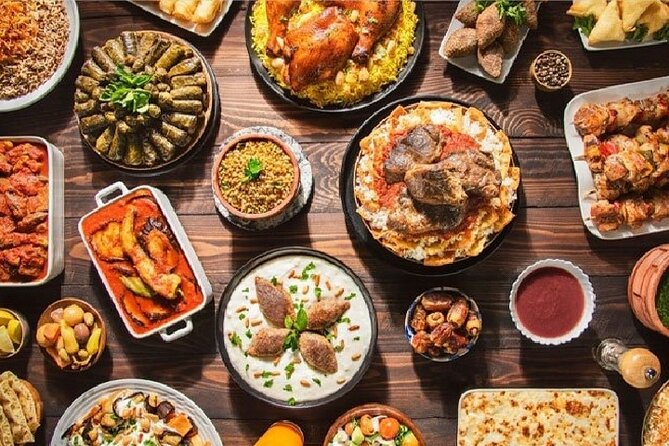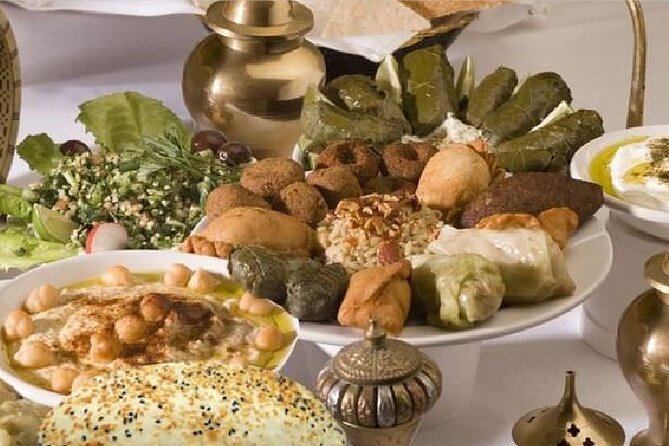Turkish Cuisine, Food, and History
Embarking on a culinary journey through Turkish cuisine is akin to unraveling a tapestry of flavors that whisper tales of centuries past. The fusion of ancient traditions and diverse influences has sculpted a gastronomic landscape that beckons exploration.
From the sizzle of succulent kebabs on open flames to the delicate sweetness of Turkish delight, each dish holds within it a piece of history waiting to be unveiled. But what lies beyond the tantalizing tastes and aromas that grace Turkish tables?
Join this exploration of Turkish culinary artistry to uncover the hidden layers of heritage and culture that intertwine seamlessly with every bite.
Key Points

- Turkish cuisine is a rich blend of flavors from various regions, creating a diverse and harmonious culinary experience.
- Culinary traditions date back to the Ottoman Empire, emphasizing cultural interactions and preservation of traditional cooking methods.
- Key ingredients like lamb, yogurt, and spices define Turkish dishes, with regional variations offering unique tastes from different parts of Turkey.
- Turkish street foods showcase a fusion of traditional flavors with modern twists, reflecting the dynamic evolution of Turkish cuisine.
Traditional Turkish Dishes
Turkish cuisine tantalizes the taste buds with a rich tapestry of flavors and aromas, showcasing a delightful blend of influences from the Middle East, Mediterranean, Central Asia, and Balkans.
Turkish spices play a crucial role in creating the distinct taste profiles of traditional Turkish dishes. These spices, such as cumin, sumac, and red pepper flakes, are skillfully combined to elevate the flavors of various dishes.
On top of that, agricultural practices in Turkey significantly impact the ingredients used in these culinary creations. The fertile lands and diverse climate allow for the cultivation of a wide range of fresh produce like eggplants, tomatoes, and olives, which form the backbone of many Turkish recipes.
This harmonious blend of Turkish spices and locally sourced ingredients results in dishes that are both flavorful and culturally significant.
Influences on Turkish Cuisine

Drawing on a rich tapestry of influences from various regions, Turkish cuisine showcases a diverse culinary heritage that has been shaped by centuries of cultural exchange and innovation. Culinary influences on Turkish cuisine include:
- Ottoman Empire: Introduced rich flavors, aromatic spices, and cooking techniques.
- Middle Eastern: Contributed ingredients like pistachios, dates, and flavors such as sumac.
- Central Asian: Brought dishes like kebabs and pilafs.
- Mediterranean: Influenced the extensive use of olive oil, herbs, and seafood.
These influences have led to modern interpretations of traditional dishes, blending old and new techniques to create a unique culinary experience that reflects Turkey’s history and cultural diversity.
Popular Turkish Street Foods

Exploring the bustling streets of Turkey reveals a vibrant tapestry of flavors and aromas that beckon foodies to indulge in the diverse array of popular street foods.
Turkish street food trends embrace authenticity while also incorporating fusion cuisine and modern twists. From the savory and aromatic kokoreç, a dish made from seasoned lamb intestines, to the classic döner kebab, thinly sliced meat wrapped in pita bread with fresh vegetables and sauces, these street foods offer a true taste of Turkey.
Simit, a circular bread encrusted with sesame seeds, is a popular on-the-go snack, while midye dolma, stuffed mussels with spiced rice, bring a unique seafood experience to the streets of Turkey.
The blend of traditional flavors with contemporary influences makes Turkish street food a must-try culinary adventure.
Historical Culinary Traditions

Wandering through the historical streets of Turkey unveils a rich tapestry of culinary traditions passed down through generations, each dish telling a story of the country’s vibrant past. Turkish historical culinary traditions bear the influence of spices and hold significant cultural importance.
- Spice Markets: Vibrant bazaars filled with colorful spices like sumac, cumin, and saffron.
- Palace Cuisine: Opulent dishes once enjoyed by Ottoman sultans, showcasing intricate flavors.
- Street Food Heritage: Traditional snacks like simit (sesame bread) and midye dolma (stuffed mussels) with ancient roots.
- Feast Rituals: Elaborate meals during celebrations, symbolizing unity and hospitality.
Regional Turkish Food Varieties

Enjoy the diverse culinary landscape of Turkey as you discover the unique regional food varieties that reflect the country’s rich cultural heritage and geographical influences. Turkish cuisine is a vibrant tapestry woven with regional influences, offering a wide range of flavors and dishes that vary from one part of the country to another. Here is a glimpse into some of the regional Turkish food varieties:
| Region | Influences | Notable Dishes |
|---|---|---|
| Marmara | Ottoman, Balkan | İskender Kebab, Manti |
| Aegean | Greek, Mediterranean | Deniz Börülcesi, Zeytinyağlı Enginar |
| Black Sea | Slavic, Caucasian | Hamsi Pilavı, Muhlama |
| Southeastern | Arabic, Kurdish | Lahmacun, Şiş Kebap |
Each region’s culinary diversity adds a unique flavor to Turkish cuisine, making it a delightful journey of tastes and traditions.
Evolution of Turkish Cooking Techniques

With a heritage steeped in centuries-old traditions and cultural influences, Turkish cooking techniques have evolved dynamically, showcasing a fusion of flavors and methods that define the country’s culinary landscape. Turkish culinary innovations and cooking methods have adapted over time, incorporating diverse elements from various regions and historical periods.
Some key aspects of the evolution of Turkish cooking techniques include:
- Use of Spices: Turkish cuisine is known for its extensive use of spices like cumin, paprika, and sumac, adding depth and complexity to dishes.
- Cooking Vessels: Traditional Turkish cooking often involves clay pots and pans, enhancing the flavors of slow-cooked dishes.
- Grilling Techniques: Turkish cuisine is famous for its mastery of grilling meats, creating succulent kebabs and köfte.
- Layering Flavors: Layering flavors through techniques like marinating and slow cooking is a common practice in Turkish cooking, resulting in rich and aromatic dishes.
Culinary Customs and Etiquette
Turkish culinary customs and etiquette reflect a deep respect for food and dining rituals, embodying a rich tapestry of traditions and social interactions. Culinary traditions in Turkey are deeply rooted in hospitality and sharing meals with loved ones. It is customary for hosts to offer guests a variety of dishes, showcasing the diversity and flavors of Turkish cuisine. Modern trends have also influenced dining practices, with more casual dining becoming increasingly popular, especially in urban areas. Below is a table highlighting some key aspects of Turkish culinary customs and etiquette:
| Customs | Etiquette | Traditions |
|---|---|---|
| Sharing is common | Seating arrangements matter | Respect for elders is important |
| Use of communal bread | Eating with right hand | Celebrating special occasions with feasts |
Turkish culinary customs blend age-old traditions with modern trends, creating a unique dining experience that is both traditional and evolving.
Signature Turkish Desserts
Experiencing the delightful array of signature desserts in Turkey unveils a tantalizing journey through the country’s rich culinary heritage and sweet traditions. Turkish sweets are a cornerstone of the nation’s dessert culture, offering a perfect blend of flavors and textures.
Some must-try signature Turkish desserts include:
- Baklava: Layers of thin pastry filled with nuts and syrup, creating a sweet and crunchy delight.
- Künefe: A heavenly mix of shredded pastry, cheese, and syrup, often served warm for a gooey treat.
- Turkish Delight: Known as Lokum, these sweet, chewy treats come in various flavors like rosewater, pistachio, and pomegranate.
- Sütlaç: A creamy rice pudding infused with aromatic flavors like cinnamon, offering a comforting and satisfying end to a meal.
Common questions
What Are Some Common Ingredients Used in Turkish Cuisine That May Be Unfamiliar to Those Outside of Turkey?
When exploring Turkish cuisine, travelers may encounter unique spices and exotic ingredients that add vibrant flavors. Traditional techniques like slow cooking and layering flavors create a rich culinary experience, offering a taste of Turkey’s diverse gastronomic heritage.
How Has Modernization and Globalization Impacted Traditional Turkish Cooking Methods and Recipes?
Modernization and globalization have revolutionized traditional cooking methods and recipes, blending diverse culinary influences. The impact of technology and fusion cuisine has sparked creativity, transforming Turkish gastronomy into a vibrant fusion of flavors, embracing innovation while preserving cultural roots.
Are There Any Specific Rituals or Traditions Associated With Mealtime in Turkish Culture?
During mealtime, Turkish culture values social etiquette and family traditions. Culinary rituals like serving tea before a meal and saying "Afiyet olsun" (Enjoy your meal) are common. These customs create a warm and welcoming atmosphere for diners.
Can You Recommend Any Lesser-Known Turkish Dishes That Are Worth Trying but May Not Be as Widely Recognized?
When it comes to exploring flavors and uncovering hidden gems, Turkish cuisine offers a treasure trove of delightful surprises. From aromatic lamb koftas to savory borek pastries, these lesser-known Turkish delicacies are definitely worth trying.
How Do Turkish Culinary Traditions Vary Between Different Regions of the Country, and What Are Some Notable Regional Specialties to Look Out For?
Turkish culinary traditions exhibit diverse regional variations influenced by local ingredients and historical influences. Notable regional specialties to savor include Black Sea’s anchovy dishes, Aegean’s olive oil-based cuisine, and Southeastern Anatolia’s flavorful kebabs.
Last Words
Set out on a culinary journey through the vibrant tapestry of Turkish cuisine, where each dish tells a story of tradition and hospitality. From savory kebabs to sweet delights, Turkish food embodies centuries of cultural influences and regional diversity.
Through history, gastronomy, and cultural insight, explore the flavors and stories behind iconic dishes like baklava and mezes. Experience the essence of Turkish food beyond taste, uncovering the rich heritage and rituals that have shaped its evolution.
Taste the flavors of Turkey and savor the memories of a culinary adventure like no other.